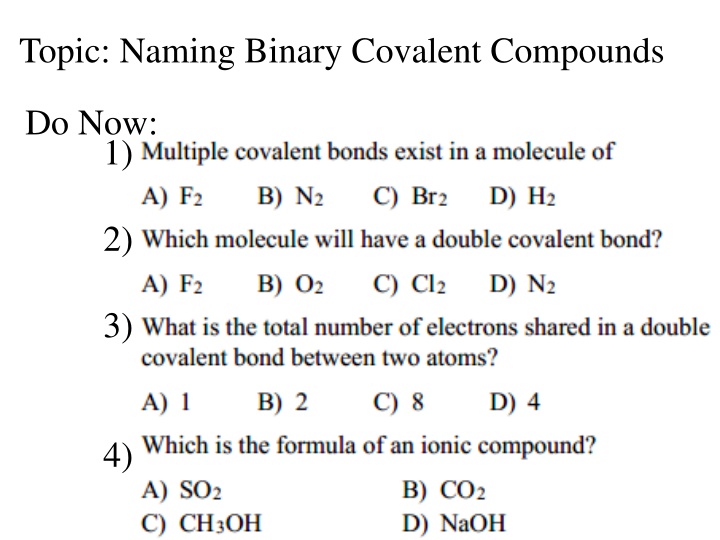
Naming of Binary Covalent Compounds
Learn about naming binary covalent compounds composed of two nonmetals, including the Stock system and Traditional system. Understand the rules for assigning oxidation numbers and the importance of electron bookkeeping in molecular substances. Explore the oxidation numbers of elements like Hydrogen and Oxygen, and grasp the concept of the sum of oxidation numbers in neutral and polyatomic compounds.
Download Presentation

Please find below an Image/Link to download the presentation.
The content on the website is provided AS IS for your information and personal use only. It may not be sold, licensed, or shared on other websites without obtaining consent from the author. If you encounter any issues during the download, it is possible that the publisher has removed the file from their server.
You are allowed to download the files provided on this website for personal or commercial use, subject to the condition that they are used lawfully. All files are the property of their respective owners.
The content on the website is provided AS IS for your information and personal use only. It may not be sold, licensed, or shared on other websites without obtaining consent from the author.
E N D
Presentation Transcript
Topic: Naming Binary Covalent Compounds Do Now: 1) 2) 3) 4)
Binary Covalent Compounds Composed of two nonmetals can be same or different
Two naming systems Stock system: learned for ionic compounds official Traditional: what hear on news what see on ingredient lists
Both Traditional & Stock a Least electronegative of two elements goes first REMINDER: electronegativity values in table S
Stock System 1st element must have Roman Numeral Have to figure out oxidation number
Stock System & Oxidation Numbers molecular substances DON T contain ions use concept of oxidation number for electron bookkeeping pretend all shared electrons go to atom with higher electronegativity value oxidation number would be: atom with higher electronegativity value has (-) oxidation number atom with lower electronegativity value is (+)
7 Rules for Oxidation Numbers # for free, uncombined element = 0 Na He O2 N2 S8 Cl2 P 1. 2. # for monatomic ion = charge on ion Ca+2 = +2 Cl-1 = -1 Al+3 = +3 3. Fluorine is always -1 CF4 +4 -1 CF4
Hydrogen is nearly always +1, except when bonded to a metal-then it s -1 4. +1 -1 +1 -1 +2 -1 HCl LiH CaH2 Oxygen is nearly always -2 EXCEPT when its: -Bonded to fluorine, where O is +2 5. +2 -1 OF2 +1 -1 H2O2 -In the peroxide ion, where O is -1
The sum of oxidation numbers in a neutral compound is 0 6. +4 -2 +2 -2 +1 -2 H2O CO2 NO +4 (1) + -2(2) = 0 +2 (1) + -2(1) = 0 +1 (2) + -2(1) = 0
The sum of oxidation numbers in a polyatomic ion = charge of the ion Sum in SO42- = -2 Sum in NO31- = -1 7. +5 -2 +6 -2 +5 (1) + -2(3) = -2 +6 (1) + -2(4) = -2 For covalent molecules, pretend they are ionic (But doesn t mean they have ions!!!)
Naming Binary Covalent Compounds Stock System
CO2 CO2: C goes first: less electronegative than O Each O is -2 so C is +4 CO2 Total = -4 Total = +4 Carbon (IV) oxide
Try SO3 so S is +6 Each O is -2 SO3 Total pos = +6 Total neg = -6 Sulfur (VI) Oxide
Try N2O3 Each O is -2 Each N is +3 N2O3 Total neg = -6 Total pos = +6 Nitrogen (III) oxide
Try P2O5 Each O is -2 Each P is +5 P2O5 Total pos = +10 Total neg = -10 Phosphorus (V) oxide
Naming Binary Covalent Compounds Traditional Naming System
Traditional Naming 1. less electronegative element named 1st 2. stem 2nd element plus -ide 3. prefixes tell how many of each element Exception: NEVER start a name with mono-
Prefixes: Traditional System # of Atoms Prefix # of Atoms Prefix 1 mono 6 hexa 2 di 7 hepta 3 tri 8 octa 4 tetra 9 nona 5 penta 10 deca
Stems: just a reminder H = hydr C = carb N = nitr O = ox F = fluor Si = silic P = phosph S = sulf Cl = chlor As = arsen Se = selen Br = brom Te = tellur I = iod
Traditional Naming H2O dihydrogen monoxide NH3 nitrogen trihydride N2H4 dinitrogen tetrahydride NO nitrogen monoxide NO2 nitrogen dioxide N2O dinitrogen monoxide
